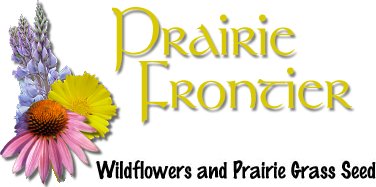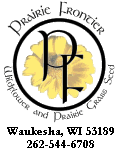
|
 |
| PF Home | PF Mixes | Prairie Grass | Native | Site Map | Planting Tips | Prairie Info | Sales |

|
 |
| Wild Geranium (spring) | Geranium maculatum | |
| Wild Columbine (spring to summer) | Aquilegia canadensis | |
| Birds Foot Violet (spring) | Viola pedata | |
| Showy Tick Trefoil (summer) | Desmodium canadense | |
| Jack-In-The-Pulpit (spring) | Arisaema triphyllum | |
| Bottle Gentian (fall) | Gentiana andrewsii | |
| Shooting Star (spring) | Dodecatheon meadia | |
| Bloodroot (spring) | Sanguinaria canadensis | |
| Culver's Root (summer) | Veronicastrum virginicum | |
|
|
| Wild Bergamot (summer) | Monarda fistulosa | |
| Black-eyed Susan (summer) | Rudbeckia hirta | |
| Spiderwort (early summer) | Tradescantia ohiensis | |
| Boneset (late summer) | Eupatorium perfoliatum | |
| Dense Blazingstar (summer) | Liatris spicata | |
| Butterfly Plant (early summer) | Asclepias tuberosa | |
| Sunflower, False (summer) | Helianthus helianthoides | |
| Lupine (late spring) | Lupinus perennis | |
| Purple Coneflower (summer) | Echinacea purpurea | |
| Joe Pye Weed (late summer) | Eupatorium maculatum | |
| Milkweed, Swamp (summer) | Asclepias incarnata | |
| Goldenrod, all (summer to fall) | Solidago spp. | |
| Purple Coneflower (summer) | Echinacea purpurea | |
| Black-eyed Susan (summer) | Rudbeckia Hirta | |
| Lance-leaved coreopsis (summer) | Coreopsis lanceolata | |
| Purple Prairie Clover (summer) | Petalostemum purpureum | |
| Maximillians Sunflower (summer to fall) | Helianthus maximillani | |
| False Sunflower (summer) | Heliopsis helianthoides | |
| Thickspiked Gayfeather (summer) | Liatris pycnostachya | |
| New England Aster (fall) | Aster novae angliae | |
| Blanket Flower (summer) | Gailardia aristata | |
| Cosmos (summer) | Cosmos bipinnatus | |
| Annual Baby's Breath (summer) | Gysophilia elegans | |
| Cornflower (summer) | Centaurea cyanus | |
| Shirley Poppy (summer) | Papaver rhoeas | |
| Yarrow (summer) | Achillia millefolium | |
| Purple Coneflower (summer) | Echinacea purpurea | |
| Black-eyed Susan (summer) | Rudbeckia hirta | |
| Lance-leaved Coreopsis (summer) | Coreopsis lanceolata | |
| Dense Blazingstar (summer) | Liatris spicata | |
| Butterfly Plant (early summer) | Asclepias tuberosa | |
| Sweet Alyssum (summer) | Lobulria maritima | |
| Annual Baby's Breath (summer) | Gysophilia elegans | |
| Cornflower (summer) | Centaurea cyanus | |
| Shirley Poppy (summer) | Papaver rhoeas | |
| California Poppy (summer) | Eschscholzia californica | |
| Wild Columbine (spring to summer) | Aquilegia canadensis | |
| Birds Foot Violet (spring) | Viola pedata | |
| Pasque Flower (spring) | Anemone patens wolfgangiana | |
| Prairie Smoke (spring) | Geum triflorum | |
| Blue Eyed Grass (spring) | Sisyrinchium campestre | |
| Prairie Phlox (spring) | Phlox pilosa | |
| Bottle Gentian (fall) | Gentiana andrewsii | |
| Shooting Star (spring) | Dodecatheon meadia | |
| Lance-leaved Coreopsis (summer) | Coreopsis lanceolata | |
| Black-eyed Susan (summer) | Rudbeckia Hirta | |
| Yellow Coneflower (summer) | Ratibada pinnata | |
| Butterfly Milkweed (early summer) | Asclepias tuberosa | |
| Purple Prairie Clover (summer) | Petalostemum purpurea | |
| Spiderwort (early summer) | Tradescantia ohiensis | |
| Dense Blazingstar (summer) | Liatris spicata | |
| Hoary Vervain (summer) | Verbena strita | |
| New England Aster (fall) | Aster novae angliae | |
| Rattlesnake Master (summer) | Eryngium yuccifolium | |
| Lavendar Hyssop (summer) | Agastache foeniculum | |
| Black-eyed Susan (summer) | Rudbeckia hirta | |
| Lance-leaved coreopsis (summer) | Coreopsis lanceolata | |
| Shooting Star (spring) | Dodecatheon meadia | |
| Dense Blazingstar (summer) | Liatris spicata | |
| Butterfly Plant (early summer) | Asclepias tuberosa | |
| Rattlesnake Master (summer) | Eryngium yuccifolium | |
| Nodding Pink Onion (summer) | Allium cernuum | |
| Purple Coneflower (summer) | Echinacea purpurea | |
| Goldenrod, all (summer to fall) | Solidago spp. | |
| Homepage | | | Native | | | Naturalized | | | Mixes | | | Prairie Grasses | | | Planting Instructions | | | Sales |
 |